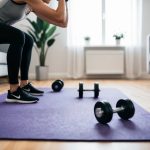Home Workout Routines: Effective Exercises for Total Fitness Without Equipment
Finding the time and resources for a comprehensive workout can be challenging. Fortunately, numerous effective exercises can be done at home without any equipment. Engaging in home workouts not only saves time and money but also allows for flexibility in a busy schedule.
Bodyweight exercises such as push-ups, squats, and planks are excellent for building strength and endurance. Simple routines incorporating these movements can target various muscle groups efficiently. These exercises provide an all-around workout suitable for beginners and fitness enthusiasts alike.
Elevating the heart rate with cardio exercises like jumping jacks or burpees enhances cardiovascular health. Consistency is key to reaping the benefits of these routines. Regular practice can lead to significant improvements in fitness levels, making them a valuable addition to anyone’s daily regimen.
Understanding Bodyweight Training
Bodyweight training involves using one’s own weight to perform exercises, making it accessible and versatile. This method enhances strength, flexibility, and overall fitness without needing equipment.
Benefits of Home Workouts
Exercising at home offers numerous advantages. The convenience of training in one’s living space saves time and eliminates the need for a gym membership. Home workouts allow for flexible scheduling and provide a comfortable environment.
Bodyweight exercises are adaptable, catering to various fitness levels. Movements like push-ups, squats, and planks can be modified to increase or decrease difficulty. This ensures continuous progression and prevents plateaus.
Additionally, home workouts often reduce the risk of injury. Without heavy weights, there’s minimal strain on joints. Plus, these exercises promote functional strength usable in daily activities.
Principles of Effective Training
To maximize results, certain principles should guide bodyweight training. Consistency is key; regular workouts ensure steady progress. Maintaining proper form prevents injuries and ensures muscles are effectively targeted.
Incorporating variety keeps routines engaging and promotes balanced muscle development. Mixing up exercises and altering routines prevents boredom and addresses all muscle groups.
Progressive overload, by gradually increasing exercise intensity, is essential. This can be achieved through added repetitions, extending hold times, or incorporating more challenging variations. Lastly, sufficient recovery time allows muscles to repair and grow, enhancing overall workout efficiency.
By adhering to these principles, one can achieve comprehensive fitness gains through bodyweight training at home. It offers an effective, flexible, and safe way to stay fit and healthy.
Creating Your Workout Space
A dedicated space for home workouts can enhance focus and productivity. It’s essential to choose a well-ventilated area with enough room to move freely.
Choosing Your Workout Area
Select an area that offers sufficient space for the range of exercises in your routine. This could be a living room, bedroom, or even an open outdoor spot. Ensure there are no obstacles like furniture or low-hanging light fixtures that could impede movement.
Natural light and ventilation are key to creating a pleasant workout environment. A window or fan can help maintain airflow and keep the area cool. Additionally, consider placing a mirror in the workout space; it helps in maintaining proper form during exercises.
Keeping your workout area tidy and organized is also important. Store any small equipment, such as yoga mats or resistance bands, in a designated spot to avoid clutter. This organization not only makes the space more inviting but also ensures safety by reducing tripping hazards.



